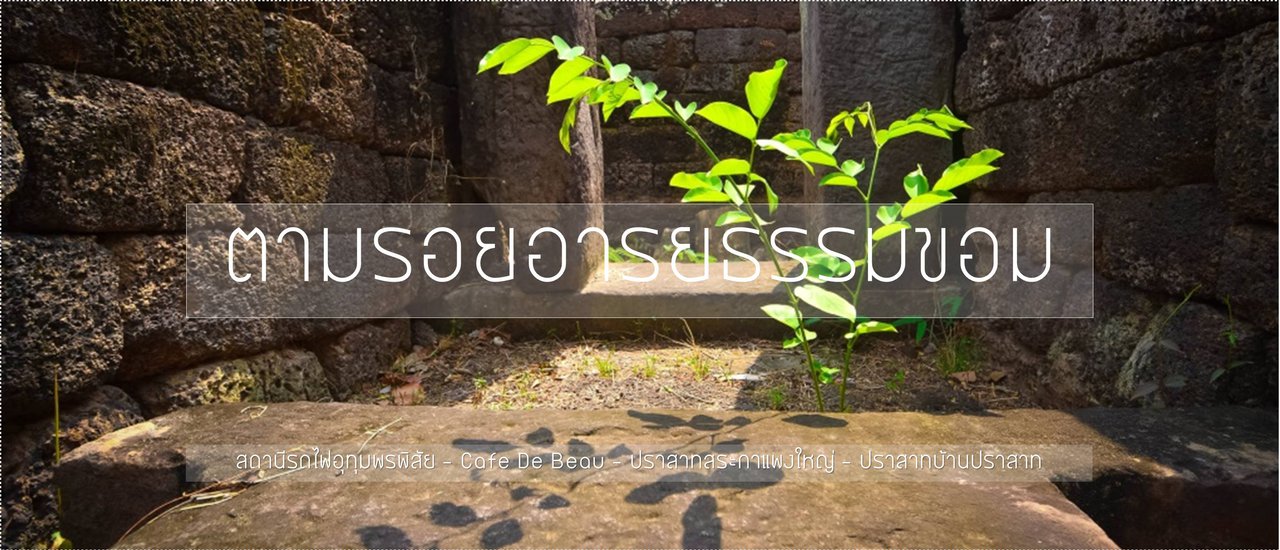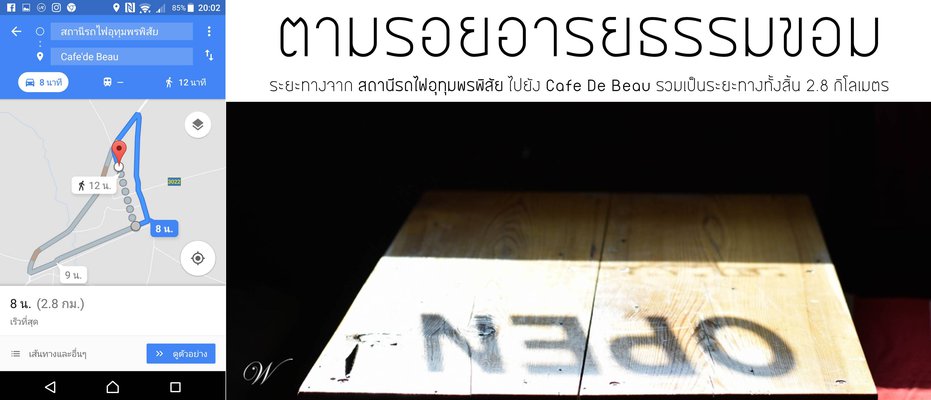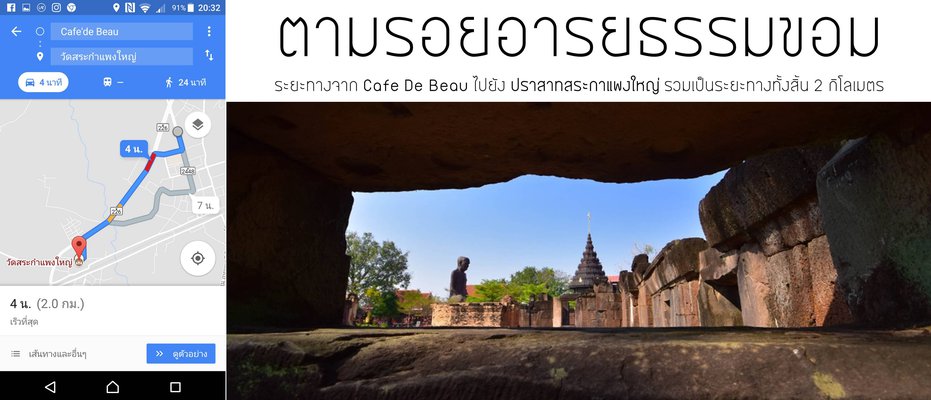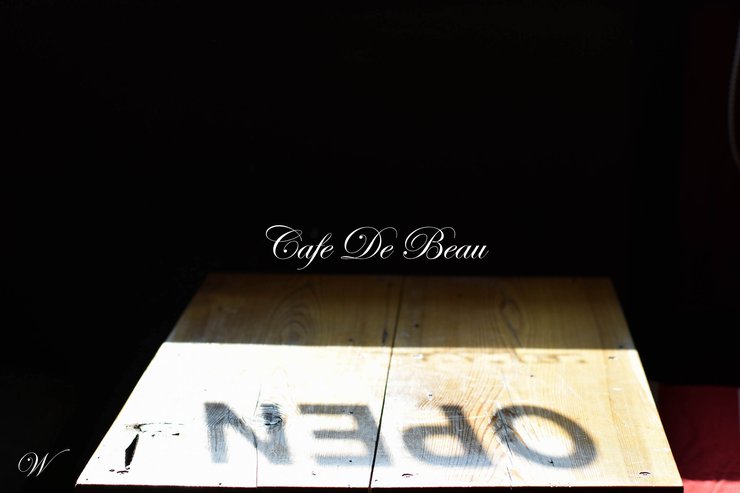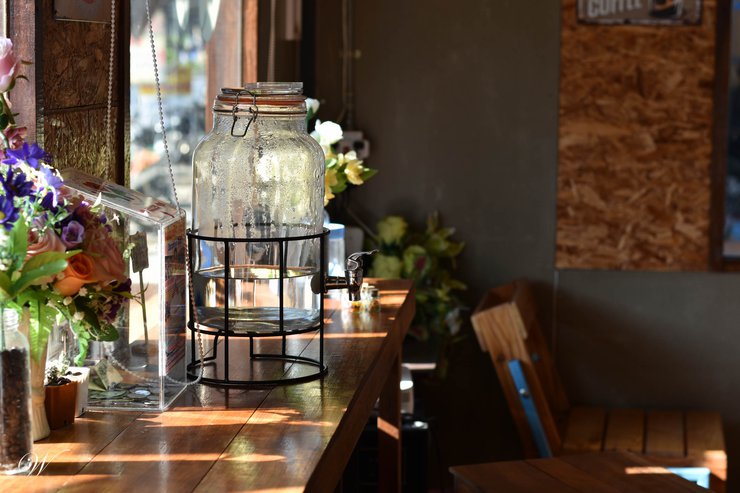
Thank you for the great information from Google Maps.

Thank you for the great information from Google Map
In this journey, we begin at Uthumphon Phisai Railway Station. The station building is located in Moo 7, Kamphaeng Subdistrict, Uthumphon Phisai District, Sisaket Province. It is easy to find, being situated in the heart of the market. Nearby, there is a traditional noodle shop, both in terms of taste and the architecture of the building. It is easily recognizable by its wooden folding doors on the left-hand side. It is highly recommended to try it! After a savory meal, on a morning like this, you might want a refreshing drink to stimulate your senses. Head over to Cafe De Beau, a blue-colored coffee shop that is easy to find near the intersection, opposite the True center.

Café de Beau

The interior of the shop is decorated with wood as the main material, making it feel both comfortable and warm at the same time.

While waiting for the blended cocoa, I grabbed a drink to sip on.

The corner by the mirror is also arranged in a lovely way, with small items on display that show attention to detail.

So cool

The food arrived at our table quickly. Let's try it.

The taste is just right, not too sweet, but still has a strong cocoa flavor. Approved!

Order some more toast with butter and milk. I'm full now. Let's go before I eat anything else.

Thank you for the valuable information from Google Maps.
Following Google Maps, you won't get lost. It's exactly 2 kilometers. You've arrived at Prasat Sra Kamphaeng Yai, also known as Prasat Si Phra Phuttha Thewarat, located within the Wat Sra Kamphaeng Yai temple grounds. It's on Pradit Pracharat Road, Village 1, Sra Kamphaeng Yai Subdistrict, Uthumphon Phisai District, Si Sa Ket Province. Easy to spot: if you see the museum, you're there!

Sra Kamphaeng Yai Museum

Wat Sa Kamphaeng Yai
Upon entering the temple gate, on the left-hand side, there is a courtyard displaying stucco sculptures that reflect the law of karma. The main castle is located on the right-hand side and is easily visible.

A sculpture exhibition reflecting the law of karma

The text provided is in Thai and translates to:
There is parking available with a bathroom next to the castle.

Towering trees, providing ample shade.

The Prasat Sra Kamphaeng Yai, a large moated castle, was declared a national historic site in the Royal Gazette, Volume 52, Issue 0 Ng, on March 8, 1935, along with several other castles in the province of Buriram. The castle is surrounded by a rectangular cloister measuring 49 meters wide and 67 meters long. Within the cloister are six brick prasats and libraries. Aerial photographs suggest that the Prasat Sra Kamphaeng Yai was once surrounded by a dense community. About 400 meters to the southeast is a large rectangular pond called "Sra Kamphaeng," which is believed to have been dug when the castle was built. To the east, a small stream called Huai Ta Hema flows through the area. This stream is a tributary of the Huai Samran.

The surrounding area is quite spacious and has a beauty typical of stone castles.
The four main components of a castle are:
1. Baray: A baray is a reservoir, an essential element of religious sites like stone castles. It served as a source of water for religious ceremonies. Typically, barays were located around or to the east of religious sites. The baray surrounding a religious site symbolized Mount Meru, surrounded by the four oceans. The eastern side was where worshippers would approach the deities, often fetching water to bathe the Shiva lingam or wash the feet of the deities. The baray at Prasat Sra Kำแพงใหญ่ is located approximately 500 meters to the east. Currently, it is no longer in its original state.
2. Ambulatory
The ambulatory is a wall surrounding the religious building, enclosing it within. This rectangular ambulatory measures 49 meters wide and 67 meters long. It features gopura entrances (gateways) on all four sides: north, south, east, and west. The base and walls are constructed from laterite, while the door and window frames are made of sandstone. Inside, there is a 3-meter wide passageway. Most of the structure remains only as the base and some sections of the walls, as the roof has collapsed and deteriorated.





3. Library or Chapel Inside the covered walkway, after passing through the east-facing gopura archway, you will find two buildings facing west. Both buildings are made of brick without mortar and stand on a rectangular laterite base with a projecting porch at the front. The sides and back are made of solid brick, but grooves are carved to create false doors that imitate real doors. These two buildings are called libraries or chapels, comparable to the Buddhist scripture halls. They were used to store religious scriptures, which were considered no less important than religious images.

The provided text is an empty paragraph with a center alignment style applied. As there is no actual content to translate, I cannot provide a translation in this instance.
Please provide the actual text you wish to be translated for me to assist you accurately.

Please translate the following sentence:

4. Prang The prang, or prasat, is the central structure of the religious site and houses the sacred images. The large enclosure of Prasat Sdok Kak Thom contains four prangs: the north prang, the south prang, and the main prang in the center. These three prangs are situated on a shared base.



The provided text is an empty paragraph containing only a line break. As there is no actual content to translate, I cannot provide a translation in this instance.
Please provide a sentence or phrase that requires translation, and I will be happy to assist you.




The provided text is an empty paragraph containing only a line break. As there is no actual content to translate, I cannot provide a translation.
Please provide a sentence or phrase for me to translate.


The entrance to the temple is typically adorned with a lintel, which depicts various narratives, often related to religious beliefs. The lintel of the Sdok Kok Thom temple, an example of Khmer art from the Kulen-Baphuon style that flourished in the 16th century CE, features intricate carvings. Notably, the temple boasts 13 lintels within its grounds, each with unique depictions. Among these, the following lintels are particularly noteworthy:
- Lintel of Vishnu Reclining on the Ocean of Milk
- Lintel of Krishna Wrestling with a Horse
- Lintel of Shiva Holding the Bull Nandi
- Lintel of Lakshmi with Elephants
- Lintel of Indra Riding the Elephant Airavata
- Lintel of Hanuman Offering a Ring

Lintel image


According to belief, there are nagas guarding the sides.

Thank you for the good information from Google Maps.
Go straight ahead for another 20 minutes by car, and you will see the sign for Ban Prasat Castle. Turn right.

Entrance sign to Prasat Ban Prasat
Prasat Huai Thap Than (Prasat Ban Prasat or Prasat Ban Non That) is located at Wat Prasat Phanaram, Ban Prasat, Moo 12, Prasat Subdistrict, Huai Thap Than District, Sisaket Province.


Prasat Phanaram Temple



The Prasat Hin Huay Tap Tan: A Historical and Architectural Gem
The Prasat Hin Huay Tap Tan, constructed during the reign of King Suryavarman I in the 16th century CE, served as a sanctuary for the deity Thimurti. This ancient Khmer temple, similar to Prasat Sri Khoraphum in Surin Province, underwent modifications in later periods, particularly in its roof structure. The three brick towers, arranged on a laterite base in a north-south orientation, are enclosed by a laterite wall with gateways. While it is believed that the temple originally had three or four entrances, only the southern gateway remains visible today.

The temple, built according to the beliefs of Brahmanism, is a contemporary art in the Pavon style. This castle has been restored in three eras, as can be seen from the neatly arranged bricks.

The central prang is slightly larger than the two flanking prangs, but its roof is lower. It is square in plan with twelve receding corners and has only one entrance on the east side. The doorway is framed by sandstone and features a lintel depicting a figure standing above a kala. The garland section contains a motif that divides the image of the figure standing in a pavilion, making it impossible to identify the individual due to the unfinished carving.





The provided text is an empty paragraph containing only a line break. As there is no actual content to translate, I cannot provide a translation in this instance.
Please provide a sentence or phrase you would like me to translate.
The two flanking prangs have been modified, especially in their roofs and doors, which are now completely sealed. The sandstone door frames and lintels remain, with the latter depicting the Churning of the Ocean of Milk scene. These lintels are located in front of the door of the southern prang.

The back of the castle

Let's focus!

Based on the local belief that those who pray here will have their wishes granted, people have been continuously visiting the shrine to pay their respects. ^^ May good deeds be rewarded.

Archaeological excavations near the castle have unearthed human skeletons and artifacts from ancient times.

I understand that you want me to translate the sentence "Please Translate

Just before the restroom.
While walking, we heard a chirping sound, so we decided to end our trip and go eat grilled chicken at Huai Thap Than instead. Thank you for reading this far. See you again in the next review.
วรัญญารีวิว
Monday, November 11, 2024 10:31 AM
Comments

